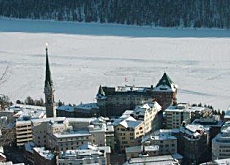
Is jet set resort going green?

It's deep winter and private jets are roaring into the high-altitude airport in the Upper Engadine, bringing the rich and famous to St Moritz.
When it comes to global warming, the alpine resort has a lot to answer for, but swissinfo meets three men who are fanning the winds of change for a more sustainable future.
In his late thirties, Markus Testa is a smartly dressed entrepreneur who runs the family business, the Testa Group, the largest of its kind in the region with its fingers in many pies: property development, construction, hotels and furniture showrooms.
Much of the business involves the building of second homes. It’s estimated that holiday properties account for nearly 60 per cent of all residences in the region.
It’s a lucrative business. In St Moritz, a square metre goes for SFr10,000-SFr30,000 ($8,000-$24,000) and there is no shortage of buyers.
Unfortunately, there are substantial environmental costs as well. On average, the residences are only occupied for six weeks in the year but are heated most of the year since temperatures at this high altitude – 1,800m – rarely rise above 20C.
But last year, Testa decided to reverse the negative climate balance. Visiting a new property development in Celerina, neighbouring St Moritz, Testa points out that all of the 60 apartments and single-family dwellings allocated for year-round residents will be heated with geothermal energy.
CO2 tax?
Testa’s aim is to instal geothermal heat pumps in all new buildings. “Renewable energy systems drive up building costs but that has been changing in the past couple of years as the price of oil continues to rise sharply,” he explains.
“And the Swiss energy policy supports the introduction of a carbon dioxide tax, which shows that politicians want us to change to alternative energy.”
Testa says the initial large investment (SFr1 million) for a special drill to bore deep into the earth will pay off since buyers will be attracted by the promise of lower heating bills and the renewable energy label.
His company was also involved in a project to make the Badrutt’s Palace hotel, one of St Moritz’s top addresses of the rich and famous, an example of renewable energy efficiency.
Water taken from a geothermal probe sunk into Lake St Moritz is converted into energy, replacing nearly 500,000 litres of heating oil a year in the hotel and neighbouring school, reducing St Moritz’s environmental impact by 1,200 tons of CO2 annually.
Climate crusader
The main promoter of renewable energy in the resort is tourist director Hans Peter Danuser.
The tireless supporter of renewable energy turned a decision to instal 180 solar panels on the sides of one of the mountain railways ahead of the 2003 World Alpine Ski Championships into a marketing opportunity.
Visits up the mountain to see the panels and a sole wind turbine became part of a “Clean Energy Tour”.
“As a tourism manager, you have to be an environmentalist because our main offer, besides the facilities and infrastructure, is still the natural environment: the scenery, the landscape, the clean water and the climate,” he says.
The “clean energy” crusader says there are about 80 projects being run under the label at present and aims to turn St Moritz into a “carbon-free resort” within ten years.
Signal
Felix Keller, head of the Tourism and Landscape Institute at the Upper Engadine’s Academia Engiadina, admits the efforts are merely a drop in the ocean.
His institute monitors environmental changes including glacial movements and changes to the layer of permafrost – the glue that keeps the mountains from crumbling – and promotes sustainable tourism.
“I think the Clean Energy projects are a good start, because they show that people are aware that they have to change their lifestyle,” Keller says. “Ideas have also been tabled to make the Upper Engadine the first Swiss region to eliminate the burning of oil and gas.
“Whether we like it or not, we will have to completely alter our heating systems over the next couple of decades.”
He sees the isolated mountain valley with its flagship resort as a model region where alternative energy systems can be introduced.
“If we could test new forms of energy, it would be a signal for the whole world.”
swissinfo, Dale Bechtel in St Moritz
The Clean Energy label was introduced at the 2003 World Alpine Ski Championships with the installation of solar panels on the tracks of one of the resort’s mountain railways.
Solar power is not only a renewable energy source but complements St Moritz’s “champagne climate” slogan since the sun reputedly shines there for 322 days of the year.
Besides visits up the mountain to see the solar panels, tourists can hike the “Climate Trail” above the neighbouring resort of Pontresina, set up by the Academia Engiadina.
Signposts explain the impact climate change has had on the mountain environment.
St Moritz is located in the Upper Engadine region of southeastern Switzerland at about 1,800m.
It is the highest Swiss community to have been awarded the government’s “Energy City” label, committing itself to introducing sustainable energy policies.
Geothermal systems usually consist of an indoor unit and a network of tubes known as a closed loop buried beneath the earth’s surface. Since underground temperatures remain relatively constant, water is circulated through the loop, absorbing the heat and transferring it to the building. The indoor unit compresses the heat to a higher temperature and distributes it throughout the building.

In compliance with the JTI standards
More: SWI swissinfo.ch certified by the Journalism Trust Initiative
















![The four-metre-long painting "Sonntag der Bergbauern" [Sunday of the Mountain Farmers, 1923-24/26] had to be removed by a crane from the German Chancellery in Berlin for the exhibition in Bern.](https://www.swissinfo.ch/content/wp-content/uploads/sites/13/2025/12/01_Pressebild_KirchnerxKirchner.jpg?ver=cb688ed5)















You can find an overview of ongoing debates with our journalists here . Please join us!
If you want to start a conversation about a topic raised in this article or want to report factual errors, email us at english@swissinfo.ch.